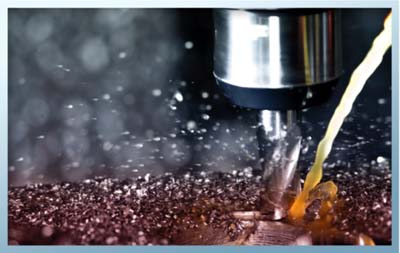
For the past three decades, our wish list as a premier, specialty chemical formulator has remained relatively unchanged. However, at the top of the list was the need for a coolant providing improved aluminum lubricity without sacrificing performance on ferrous metals; true multi-metal capabilities. Of near-equal importance has been the need for a bio-resistant formulation that does not rely on heavy concentrations of biocides and fungicides. Effective tramp oil rejection is necessary in order to maintain consistently high levels of performance in the presence of lubricant contaminants while minimizing smoke and mist. And finally, and perhaps the most elusive, has been the ultimate desire to develop a fully-synthetic coolant with the performance characteristics of soluble oils.
International Chemical Company has introduced the 7900 Series of Machine and Grinding Coolants. International Compound #7950 is a full-synthetic meeting all of the aforementioned criteria. This coolant has been engineered with bio-stable additives that reportedly eliminate the added cost and labor of sump-side biocides, fungicides and defoamers. International Compound #7951 is a semi-synthetic coolant which utilizes the very same platform, but with 7 percent of a hydro-treated, premium naphthenic oil providing enhanced lubricity, particularly in tapping operations and those incorporating specific grades of aluminum.
Contact Details
Related Glossary Terms
- coolant
coolant
Fluid that reduces temperature buildup at the tool/workpiece interface during machining. Normally takes the form of a liquid such as soluble or chemical mixtures (semisynthetic, synthetic) but can be pressurized air or other gas. Because of water’s ability to absorb great quantities of heat, it is widely used as a coolant and vehicle for various cutting compounds, with the water-to-compound ratio varying with the machining task. See cutting fluid; semisynthetic cutting fluid; soluble-oil cutting fluid; synthetic cutting fluid.
- grinding
grinding
Machining operation in which material is removed from the workpiece by a powered abrasive wheel, stone, belt, paste, sheet, compound, slurry, etc. Takes various forms: surface grinding (creates flat and/or squared surfaces); cylindrical grinding (for external cylindrical and tapered shapes, fillets, undercuts, etc.); centerless grinding; chamfering; thread and form grinding; tool and cutter grinding; offhand grinding; lapping and polishing (grinding with extremely fine grits to create ultrasmooth surfaces); honing; and disc grinding.
- lubricity
lubricity
Measure of the relative efficiency with which a cutting fluid or lubricant reduces friction between surfaces.
- tapping
tapping
Machining operation in which a tap, with teeth on its periphery, cuts internal threads in a predrilled hole having a smaller diameter than the tap diameter. Threads are formed by a combined rotary and axial-relative motion between tap and workpiece. See tap.
- tramp oil
tramp oil
Oil that is present in a metalworking fluid mix that is not from the product concentrate. The usual sources are machine tool lubrication system leaks.







